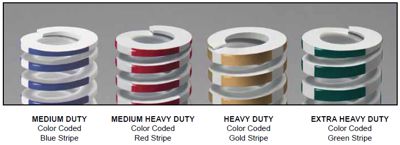Lamina Die Springs Catalog
 Lamina die springs are made in America by Dayton Lamina. The brand name is DieMax. The color codes, sizes, pressures, and travels to solid are similar to the popular Raymond Die Springs.
Lamina die springs are made in America by Dayton Lamina. The brand name is DieMax. The color codes, sizes, pressures, and travels to solid are similar to the popular Raymond Die Springs.
Blue stripe indicates Medium Duty with the lightest pressure and longest travel to solid. Red stripe indicates Medium Heavy Duty. Gold (Yellow) stripe indicates Heavy Duty. Green stripe indicates Extra Heavy Duty with the highest pressure and shortest travel. This is different than the ISO color code of Danly Die Springs.
Die Springs Product Features
♦ For same day shipments, we stock them so you don’t have to
♦ Inch sizes manufactured to industry standard colors
♦ Yields reliable, trouble-free performance
♦ Manufactured in an ISO 9001:2008 certified facility
♦ Manufactured from spring-quality Chromium Silicon alloy, high-tensile strength steel in accordance with ASTMA A1000-99 specifications
♦ Optimal rectangular wire design
♦ Also known as Dayton Lamina die springs or Anchor Lamina die springs
♦ Made in America
Die Spring Basics
A die spring is a highly engineered mechanical spring with specific wire designs that stores energy elastically by resisting movement when pressure is applied. The desired wire segment is selected to produce the maximum amount of force within a minimal amount of space.
Altering Die Springs Each die spring is carefully engineered to perform within specific applications. Under no circumstances should you alter a die spring. Altering a die spring will change its designed characteristics and allows additional stresses to occur causing early failure. Grinding on the die spring not only changes the spring’s original properties, but the heat from grinding can change the temper of the material and negatively affect the spring’s performance.
Compressed Length The sum of the preload travel and operating travel.
Corrosion Frequently, die spring failure can be traced to corrosive elements which affect the surface of the spring’s material, causing premature failure. Be aware of conditions that may affect the spring’s surface such as rust, lubricants, soaps, and chemicals. Clean, protected die springs provide the best performance.
Cycle Rate The more rapidly a spring is cycled, the greater the need to operate in the recommended long life deflections from the catalog.
Die Spring Guidance Make sure that the hole size and/or rod size match the die spring’s operating dimensions.
Duty Ranges We offer 4 separate duty ranges to best suit your applications – Medium Duty, Medium Heavy Duty, Heavy Duty, and Extra Heavy Duty. Do not mix springs of different duties.
Free Length The length of the spring without any load or force applied.
Hole Diameter Die springs are designed to be used in a hole dimension as indicated in the catalog. The actual O.D. will be somewhat smaller to prevent interference.
Material In our case, the spring material is High Tensile Strength Chrome Silicon Material. We use an optimal rectangular wire design. The maximum rated service temperature is 425°F.
Operating Travel is the deflection of the spring where it is operating between the preload and the total travel of the spring during operation. This is the area where the actual work is performed.
Preload The initial force which is applied to a die spring. Preload is recommended to compress the first coils at each end where additional stresses are present because of the turn-down of the end coils. Applying a preload will extend the life of the spring.
Quality Our die springs are manufactured in an ISO9001-2008 facility.
Rates Die spring rates are normally listed as Pounds per Inch of deflection (i.e. 60 pounds load per inch.) As a die spring is deflected, the loads will increase for the amount of travel it is deflected. That is, a spring with a 60lb/inch rate will produce 60 lbs of resistance at 1″ of travel, 120 lbs. at 2″ of travel, etc. For purposes of simplification, the loads in
our catalog are shown in pounds needed to deflect a spring 1/10th of an inch. Simply multiply the rates given by 10 to determine the actual spring rate.
Rod Diameter Die springs are designed to fit over a rod for guidance and the actual I.D. of the spring is actually somewhat larger to fit over a rod without interference.
Solid Height Solid height is the height of the spring when all of the coils are totally collapsed to solid. You never want to operate a die spring close to this condition.

